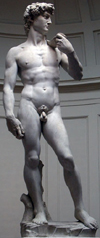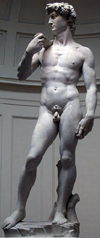





Historical Artistic Background
The origin of Florence goes back to the period of the Etruscan civilization. According to some historians, the Etruscans of Fiesole were the first to settle in the Arno valley. Later the Romans, after the war of Sulla, occupied this fertile location, and Caesar's veterans founded, on the banks of the river, the colony with the auspicious name of "Florentia". St. Miniato, who brought Christianity to Florence, was here martyred in the III century. During the barbaric invasions, Florence suffered the harsh times of the other Italian cities. In 1115, after having weakened the feudal Lords, the Florentine people formed a free Commune. After nearby Fiesole was conquered (1125), a second circle of walls was built around Florence. From the XII to the XVI centuries, Florence aesthetically acquires that physiognomy that she still maintains, characterized by the classical sense of proportion and the chromatic marble decoration. In architecture, this first period is exemplified by the Churc of San Miniato and the Baptistry, while in sculpture, the Pulpit of San Miniato (1207) is the most notable example. In art, the great personalities of Cimabue and Giotto stand out and Dante becomes an important literary figure. At the end of the XIII cent, three important churces are erected: Santa Maria Novella for the Dominicans, Santa Croce for the Franciscans and the Cathedral, testimony to how Northern linearism is transformed in vast spaces with vigorously conceived monumental forms. Together with religious architecture, civilian construction develops, the most notable examples being: the Palace of the Bargello, The Palazzo Vecchio and the Loggia of the Signoria. With Dante (1265-1321) and Giotto (1266-1337), Florence begins her glorious era in culture and art. In the school of Arnoldo di Cambio (1204-1302) and that of Giotto, Andrea Pisano da Pontedera (1295-1345), author of the first Baptistry gates, forms his style. Cimabue (1240-1302) surpasses the Byzantine formulas still loitering in Florence. Giotto, his great pupil, frees Florentine art from all its ties with the past, introducing to art, especially painting, a new human language, rendered with profound and attentive observation.

From Giotto derive Taddeo Gaddi, Bernardo Daddi, Masi di Banco and many others. The great XIV century artists announce the coming of the XV century, glorious period of the Renaissance (rebirth) during which time Florence re-lives the illustrious era that Athens knew in ancient Greece. Filippo Brunelleschi (1377-1446), architect, erects constructions based on a new conception of proportion and volume derived from classic art. Donatello (1386-1466), friend and collaborator of Brunelleschi, freeing sculpture from all Gothic influence, creates his masterpieces, rich with profound humanity due to his attentive observation of nature. Masaccio (1401-1428) despite his brief lifetime, inspired by Donatello and above all Brunelleschi, introduces new elements of perspective and color in his creations that make him the the first Renaissance painter. His frescoes in the Carmine Church, monumentally figurative in their powerful humanity, open new and more vast horizons to italian art.
Servizi per le Aziende: acquista la tua visibilità su Info Florence.com Contact Us